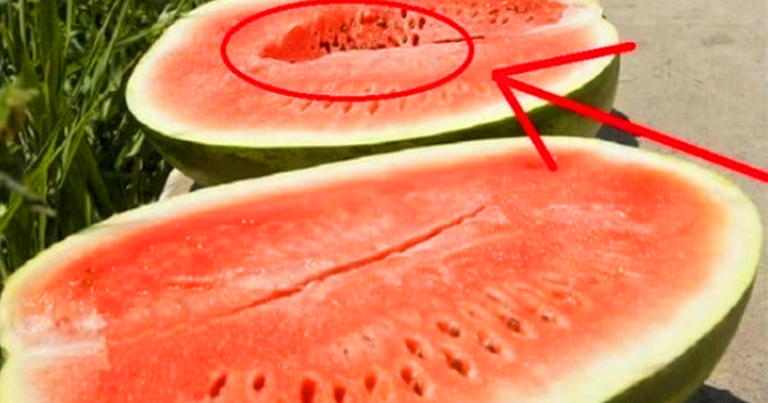Watermelon is a beloved fruit, especially when the summer sun is blazing. Its juicy, refreshing flesh makes it the perfect treat to cool down, and its hydrating properties are undeniable. Packed with vitamins, natural sugars, and energy, watermelon seems like the perfect snack. However, while this summer staple is often celebrated for its health benefits, there are hidden dangers associated with it that many people are unaware of. One of the most concerning issues is the presence of cracks inside watermelons, which can indicate serious health risks. This article explores both the benefits and potential dangers of consuming watermelon, ensuring you can enjoy this fruit safely.

The Nutritional Powerhouse: Benefits of Watermelon
Watermelon isn’t just tasty; it’s incredibly nutritious. Comprised of about 92% water, it’s an excellent way to stay hydrated during hot weather. The high water content also gives watermelon its natural diuretic effect, helping to flush toxins from the body and supporting kidney function. But hydration isn’t the only benefit.
Watermelon is rich in vitamins A and C, which are essential for skin health and immune function. Vitamin A helps maintain healthy vision, while vitamin C is a powerful antioxidant that protects your cells from damage. Additionally, watermelon contains lycopene, a potent antioxidant linked to heart health and reduced risk of certain types of cancer. With these benefits, it’s no wonder watermelon is a favorite among health-conscious individuals.
Refreshing and Hydrating: Perfect for Hot Days
When temperatures soar, there’s nothing quite like biting into a cold slice of watermelon. The fruit’s refreshing nature is due in large part to its high water content, which not only quenches your thirst but also helps regulate your body temperature. On a hot day, eating watermelon can provide immediate relief, making it a go-to snack for outdoor activities, picnics, and barbecues.
Moreover, watermelon’s natural sugars provide a quick energy boost, perfect for recharging after physical activity. The combination of hydration, nutrients, and energy makes watermelon an ideal summer food.
Affordability and Availability: Why Watermelon is a Household Staple
One of the great things about watermelon is its accessibility. It’s widely available during the summer months, and compared to other fruits, it’s relatively inexpensive. A single watermelon can last for several days, making it a cost-effective choice for families. Its versatility also adds to its appeal—whether eaten fresh, blended into smoothies, or added to salads, watermelon is a delicious and easy addition to your diet.
The Hidden Dangers: When Watermelon Becomes Harmful

While watermelon is generally safe and healthy, not all watermelons are created equal. One of the most alarming issues that can occur with watermelon is the presence of internal cracks. These cracks are often overlooked, but they can be a sign of something much more concerning.
The appearance of cracks inside a watermelon is usually the result of exposure to a chemical growth enhancer called forchlorfenuron. This substance is sometimes used by growers to accelerate the growth of fruits, including watermelons, to increase their size and marketability. However, forchlorfenuron is not without its risks.
Understanding Forchlorfenuron: The Chemical Behind the Cracks
Forchlorfenuron is a synthetic plant growth regulator that has been linked to various health concerns. Its use in fruit production, while effective for increasing yield, can lead to the formation of cracks inside the fruit as it grows too rapidly for its skin to keep up. These cracks are more than just an aesthetic issue—they can be a red flag for potential health risks.
Consuming watermelon with internal cracks may expose you to forchlorfenuron residues, which have been associated with serious health problems. Some studies suggest that long-term exposure to this chemical could increase the risk of cancer and neurological disorders. While the occasional consumption of such watermelon might not pose an immediate threat, regular intake could lead to significant health issues over time.
Recognizing the Signs: How to Spot Dangerous Watermelon

To protect your health, it’s important to know how to identify watermelons that may have been treated with forchlorfenuron or other harmful chemicals. The most obvious sign is the presence of large, irregular cracks inside the flesh of the watermelon. If you cut open a watermelon and see these cracks, it’s best to err on the side of caution and avoid consuming it.
In addition to internal cracks, you should also be cautious of watermelons that have an unusually shiny or hard exterior, as these could be indicators of chemical treatment. Always choose watermelons that have a natural, slightly dull appearance with no obvious blemishes or deformities.
Prioritizing Your Health: Safe Watermelon Consumption

Given the potential risks associated with chemically treated watermelons, it’s crucial to prioritize your health by making informed choices. Whenever possible, purchase watermelons from trusted sources, such as local farmers or organic markets, where the use of harmful chemicals is less likely. Additionally, wash the outer surface of the watermelon thoroughly before cutting into it, as this can help remove any chemical residues on the rind.
If you do come across a watermelon with internal cracks, discard it immediately. Remember, it’s always better to be safe than sorry when it comes to your health.
Conclusion: Enjoy Watermelon with Caution
Watermelon is undoubtedly one of the most refreshing and nutritious fruits, especially during the hot summer months. Its ability to hydrate, energize, and provide essential vitamins makes it a favorite among many. However, as with any food, it’s important to be aware of potential risks. The presence of internal cracks in watermelon, often caused by chemical growth enhancers like forchlorfenuron, can pose serious health hazards.
By staying vigilant and choosing your watermelons carefully, you can continue to enjoy this delicious fruit without compromising your health. So, the next time you slice into a watermelon, take a moment to inspect it—your health is worth it.


